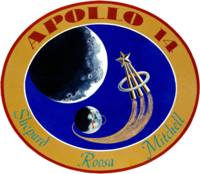Apollo 14
| Apollo 14 | |||
 | |||
| Statistik för uppdraget | |||
|---|---|---|---|
| Uppdrag | Apollo 14 | ||
| NSSDC-ID | Kommandomodul: 1971-008A[1] Månlandare: 1971-008C[2] | ||
| Anrop | Kitty Hawk Kommandomodul Antares Månlandare | ||
| Varaktighet | 9 dag, 1 min, 58 sek | ||
| Uppskjutning | |||
| Raket | Saturn V SA-509 | ||
| Uppskjutningsramp | Kennedy Space Center, LC 39A | ||
| Uppskjutning | 31 januari 1971 21:03:02 UTC | ||
| Landning | |||
| Landning | 9 februari 1971 21:05:00 UTC Stilla Havet 27°1′S 172°39′V / 27.017°S 172.650°V | ||
| Månen | |||
| Antal varv kring månen | 33 varv | ||
| Tid i omloppsbana kring månen | 66 tim, 35 min, 40 sek | ||
| Månprover, vikt | 42,8 kg | ||
| Antal månpromenader | 2 st | ||
| Månpromenader, längd | 9 tim, 22 min, 31 sek | ||
| Tid på månen | 5 februari 1971 09:18:11 UTC | ||
| Landnings plats | Fra Maurokratern | ||
| Dockning | |||
| Dockning | 1 februari 1971 01:57:58 UTC | ||
| Ur dockning | 5 februari 1971 04:50:43 UTC | ||
| Andra dockningen | 6 februari 1971 20:35:52 UTC | ||
| Andra ur dockning | 6 februari 1971 22:48:00 UTC | ||
| Besättning | |||
| Besättning | 3 | ||
| Befälhavare | Alan Shepard | ||
| Pilot | Stuart Roosa (kommandomodulen) Edgar D. Mitchell (månlandaren) | ||
 | |||
| Kronologi | |||
| |||
Apollo 14 var den åttonde bemannade rymdfärden i Apolloprogrammet, den fjärde bemannade expeditionen till månen och den tredje av dessa som fullföljde uppdraget och landade på månen. Flygningen skulle gjorts redan 1970, men flyttades fram på grund av Apollo 13s olyckossamma färd i april 1970. Man landade i Fra Maurokratern, man skulle ursprungligen ha landat i Littrow kratern, men då Apollo 13 inte kunde landa på månen övertog Apollo 14, Apollo 13s landningsplats.
Besättning
- Alan Shepard, befälhavare
- Edgar D. Mitchell, månlandarpilot
- Stuart Roosa, kommandomodulpilot
Se även
Referenser
- ^ ”NASA Space Science Data Coordinated Archive” (på engelska). NASA. https://nssdc.gsfc.nasa.gov/nmc/spacecraft/display.action?id=1971-008A. Läst 27 mars 2020.
- ^ ”NASA Space Science Data Coordinated Archive” (på engelska). NASA. https://nssdc.gsfc.nasa.gov/nmc/spacecraft/display.action?id=1971-008C. Läst 27 mars 2020.
Externa länkar
 Wikimedia Commons har media som rör Apollo 14.
Wikimedia Commons har media som rör Apollo 14.
| |||||||||||||||||||||||||||||||||||||||||||
| |||||||||||||||||||||||||||||||||
Media som används på denna webbplats
Författare/Upphovsman: Pascal (Flickr user: pasukaru76), Licens: CC0
Vostok spacecraft replica at the Technik Museum Speyer, Germany.
Logo of Apollo 15
This is the insignia designed for the Apollo 15 lunar landing mission. The circular design features the colors red, white and blue. On the outer portion of the patch a narrow band of blue and a narrow band of red encircle a wider band of white. The large disc in the center of the emblem has red, white and blue symbols of flight, superimposed over an artist's concept of the Apollo 15 Hadley-Apennine landing site of gray tone. The surnames of the three names are centered in the white band at the bottom of the insignia. The Apollo 15 prime crew men are David R. Scott, commander; Alfred M. Worden, command module pilot; and James B. Irwin, lunar module pilot.
Logo Apollo 13
This is the insignia of the Apollo 13 lunar landing mission. The Apollo 13 prime crew were the astronauts James A. Lovell Jr., commander; Thomas K. Mattingly II, command module pilot; and Fred W. Haise Jr., lunar module pilot. Represented in the Apollo 13 emblem is Apollo, the sun god of Greek mythology, symbolizing how the Apollo flights have extended the light of knowledge to all mankind. The Latin phrase Ex Luna, Scientia means "From the Moon, Knowledge." Apollo 13 was intended to be the National Aeronautics and Space Administration's (NASA) third lunar landing mission.
Shepard and Mitchell erect flag on lunar surface (video) - Apollo 14
The prime crew of the Apollo 14 lunar landing mission. From left to right they are: Command Module pilot, Stuart A. Roosa, Commander, Alan B. Shepard Jr. and Lunar Module pilot Edgar D. Mitchell. The Apollo 14 mission emblem is in the background.
This is the Apollo 14 crew patch designed by astronauts Alan B. Shepard Jr., commander; Stuart A. Roosa, command module pilot; and Edgar D. Mitchell, lunar module pilot. It features the astronaut lapel pin approaching the Moon and leaving a comet trail from the liftoff point on Earth. The pin design was adopted by the astronaut corps several years ago. Astronauts who have not yet flown in space wear silver pins. Those who have flown wear gold pins.











